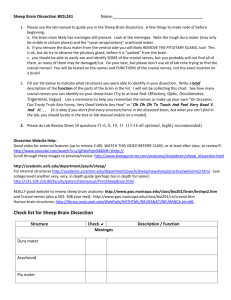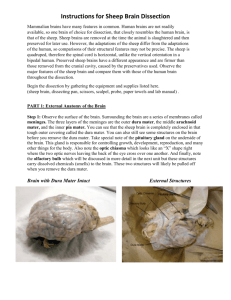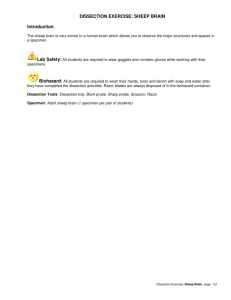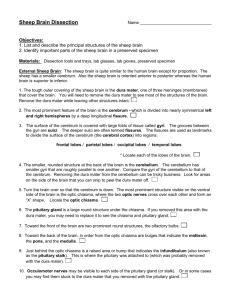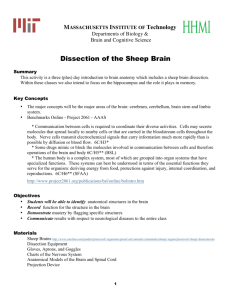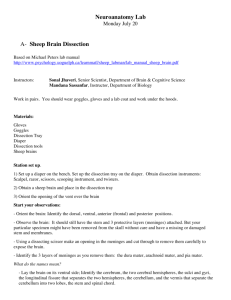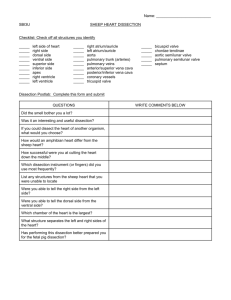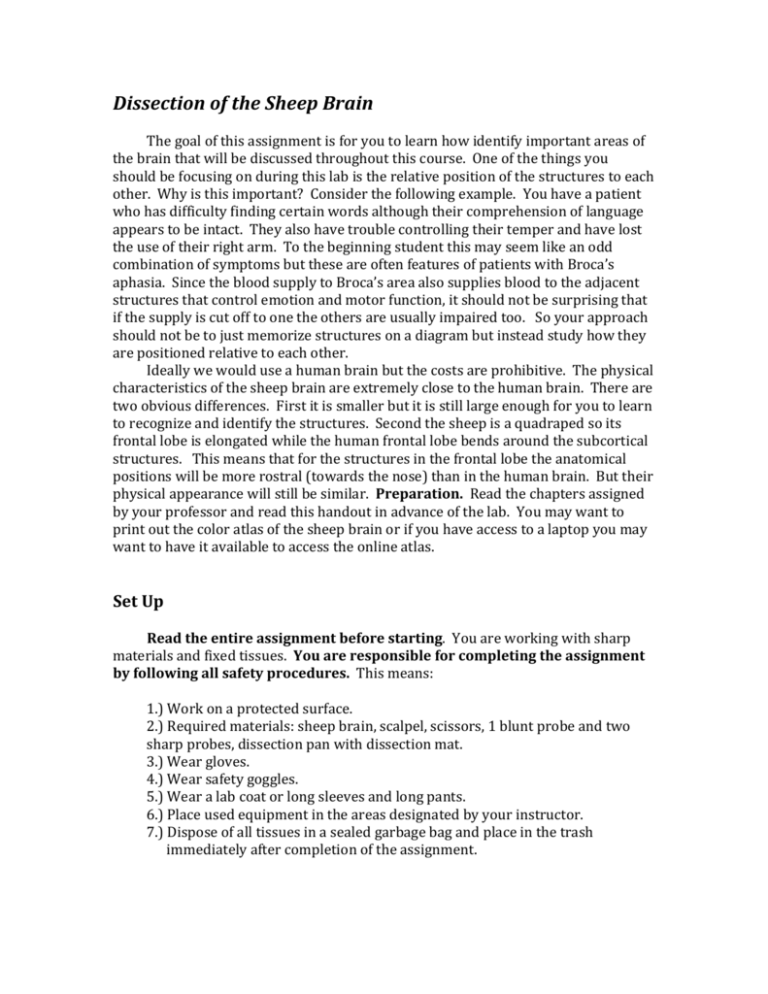
Dissection of the Sheep Brain The goal of this assignment is for you to learn how identify important areas of the brain that will be discussed throughout this course. One of the things you should be focusing on during this lab is the relative position of the structures to each other. Why is this important? Consider the following example. You have a patient who has difficulty finding certain words although their comprehension of language appears to be intact. They also have trouble controlling their temper and have lost the use of their right arm. To the beginning student this may seem like an odd combination of symptoms but these are often features of patients with Broca’s aphasia. Since the blood supply to Broca’s area also supplies blood to the adjacent structures that control emotion and motor function, it should not be surprising that if the supply is cut off to one the others are usually impaired too. So your approach should not be to just memorize structures on a diagram but instead study how they are positioned relative to each other. Ideally we would use a human brain but the costs are prohibitive. The physical characteristics of the sheep brain are extremely close to the human brain. There are two obvious differences. First it is smaller but it is still large enough for you to learn to recognize and identify the structures. Second the sheep is a quadraped so its frontal lobe is elongated while the human frontal lobe bends around the subcortical structures. This means that for the structures in the frontal lobe the anatomical positions will be more rostral (towards the nose) than in the human brain. But their physical appearance will still be similar. Preparation. Read the chapters assigned by your professor and read this handout in advance of the lab. You may want to print out the color atlas of the sheep brain or if you have access to a laptop you may want to have it available to access the online atlas. Set Up Read the entire assignment before starting. You are working with sharp materials and fixed tissues. You are responsible for completing the assignment by following all safety procedures. This means: 1.) Work on a protected surface. 2.) Required materials: sheep brain, scalpel, scissors, 1 blunt probe and two sharp probes, dissection pan with dissection mat. 3.) Wear gloves. 4.) Wear safety goggles. 5.) Wear a lab coat or long sleeves and long pants. 6.) Place used equipment in the areas designated by your instructor. 7.) Dispose of all tissues in a sealed garbage bag and place in the trash immediately after completion of the assignment. Part 1: Dissection View the film “Dissecting the Sheep Brain” and then you can proceed. You may want your laptop nearby to be able to refer back to the dissection film if you have problems. Write the answers to all questions directly on this handout. Figure 1. The dura mater (A) is a tough outer membrane that protects the brain by allowing it to float in cerebral spinal fluid. 1.) Remove the dura mater (if present). Place the brain on its ventral surface as shown in Figure 1. Notice the tough outer membrane and the gap between it and the brain. This gap would normally contain cerebral spinal fluid (CSF). CSF acts as a shock absorber. The brain floats in the CSF which cushions your brain from injury should you fall or if the head is hit. Remove the dura mater from your specimen by taking your dissecting scissors and making a hole in the dura mater. Be careful not to hit the brain. This is a tough substance and will take some effort (hence the name dura mater which means tough substance). When you have removed it throw it away. Note: we are not always able to obtain specimens with the dura mater present due to cost and availability. If yours does not have the dura mater focus on the removal of the dura mater in the online dissection film. 1.) The dura mater…. a.) protects the brain. b.) means tough substance. c.) serves as a protective case to contain CSF and allows the brain to float within the skull. d.) all of these. 2.) Place the brain on its ventral surface as shown in Figure 2. Notice the fissures in the cortex (the dark lines are brain capillaries in the fissures). The folding over of the cortex has the effect of increasing the size of the cortex to allow more cells in a smaller space (imagine how much less space a sheet takes up when it is folded compared to when it is spread out). Find each of the structures listed in Table 1 on your specimen. Now complete the table below by entering the number that corresponds to the correct anatomical name for each structure indicated in Table 1. If you need help refer to your reading notes, the atlas and the sheep dissection video. Table 1. Identification of Dorsal Structures. The letters refer to the labels in Figure 2. Enter the number from Anatomical Name Figure 2 Medial longitudinal fissure Cerebellum Spinal Cord Cerebral Cortex Figure 2. View of the dorsal surface of the brain with the dura mater removed. 3.) Place the brain on its dorsal surface as shown in Figure 3. Find each of the ventral surface structures listed in Table 2 on your specimen. Using your reading notes complete the table below by listing at least one behavior that is associated with the structure listed and enter the number corresponding to each structure’s correct location in Figure 3. Table 2. Ventral Structures The letters refer to the labels in Figure 3. Enter the correct letter Anatomical Name Enter one Behavior Olfactory bulb Optic chiasim Optic tract Pons Spinal cord Cerebellum Midbrain Pyriform lobe Medulla Pituitary stalk Mammillary bodies Figure 3. View of the ventral surface of the brain. Figure 4. Sagittal view of the brain 5 mm lateral from midline. 4.) Place the brain back on its ventral surface and using the scalpel cut the brain into two halves by cutting down the medial longitudinal fissure as shown in the sheep dissection film. You will have two identical halves in the sagittal plane. Now using the ruler in your dissection kit measure 5 mm lateral to midline and make a second longitudinal scalpel cut. This will give you the view shown in Figure 4. Retain the other half for later. Compare each side of the 5 mm thick section before proceeding. Using Figure 4, identify two structures shown in Figure 4 that are not present at midline. 4.) The two structures that are visible 5 mm lateral from midline but not visible at midline are the _________________ and _____________ a.) hippocampus; basal ganglia b.) cerebral cortex; cerebellum c.) thalamus; hypothalamus d.) spinal cord; pons Next find each of the structures listed in Table 3 both on the diagram shown in Figure 4 and on your specimen. Then using your reading notes, the sheep brain atlas and your specimen complete the table below by listing at least one behavior that is associated with each structure and the number which correctly identifies its position on Figure 4. Note numbers may be used once, reused or not used at all. Table 3. Structures 5 mm Lateral to Midline. Use Figure 4 to complete Table 3. Enter Correct Number Anatomical Name Enter One Behavior Medulla Pons Cerebellum Cerebral Cortex Superior Colliculus Midbrain Basal Ganglia Hypothalamus Optic Chiasm Thalamus Spinal Cord Hippocampus Part 2: Dissection of the Hippocampus and the Case of H.M.. 5.) Using the other intact hemisphere remove the hippocampus in one piece as shown in the dissection film. As you remove the hippocampus note its location to the adjacent structures. You will need your blunt probe and scalpel. If you need help, then review the dissection video. Draw a diagram of the dissected hippocampus (indicate the dorsal and ventral ends and if the following structures are located within one cm of the hippocampus also include their relative position in your diagram: thalamus, cortex, basal ganglia, cerebellum, third ventricle and hypothalamus. 6.) In one of the most famous cases in neuropsychology, the hippocampus was removed from H.M.’s brain to treat his epilepsy. What other structure also had to be damaged in order to remove the hippocampus? a.) cortex b.) thalamus c.) basal ganglia d.) hypothalamus 7.) In approximately 1/3 of patients with schizophrenia the ventricles near the hippocampus become enlarged? If the third and lateral ventricles are enlarged which areas could be getting smaller? Circle all possibilities. a.) medulla b.) thalamus c.) cerebellum d.) pons e.) hippocampus This Course Resource was provided by NeuroscienceCourses.com All rights reserved

